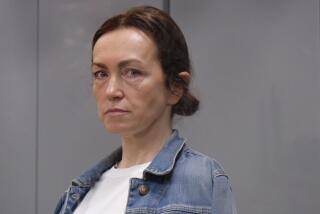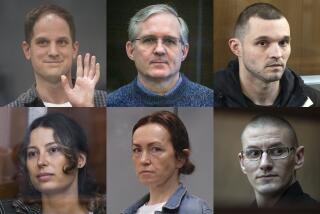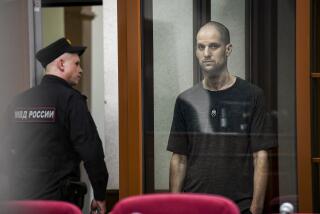As trialâs penalty phase begins, Boston Marathon bomber remains a mystery
Reporting from Boston â Each morning around 9 a.m., a courtroom door would swing open and a young man in a sport coat was escorted by beefy U.S. marshals to the defense table.
For a few moments, the 21-year-old defendant appeared animated, smiling a bit with lawyers, fussing with his thick, dark hair.
But once the jury arrived and the judge gaveled the trial to order, Dzhokhar Tsarnaev became someone totally different â detached, dismissive and difficult to read.
Gone was the smile. During hours of testimony, Tsarnaev mostly looked down, fingering through a few notebooks or doodling in a yellow pad.
As morning became afternoon, he sometimes sank deeper in his chair, his chin in his hand, looking bored and uninterested, even during heart-wrenching stories from victims of the April 2013 Boston Marathon bombing.
Rarely did Tsarnaev look at the witnesses directly in front of him, some in wheelchairs or prosthetics. He never seemed to view the jury, either, even when they declared him guilty of the worst terrorist attack in the United States since Sept. 11, 2001.
Precious little has come out â in direct testimony or courtroom behavior â about how Tsarnaev feels today about the attack that killed three people and injured more than 260.
That could be about to change.
When the penalty phase of the trial opens Tuesday, prosecutors are likely to offer new details about Tsarnaevâs embrace of violent Islamic radicalism and anti-Americanism.
His lawyers probably will respond by calling old friends and associates to portray the Russian immigrant as a troubled college student, lured away from typical youthful pursuits like Facebook and Twitter by a domineering older brother who masterminded the attack.
âThe sentencing phase is going to be fascinating,â said J. Reid Meloy, a San Diego psychologist and longtime criminal consultant. âYouâre going to hear from doctors about his history and youâll get a tremendous amount of data. The doors are going to be thrown wide-open on him.â
But even as his past is dissected and his future is largely known â because the only options are death or life in prison without parole â the Tsarnaev of today remains the single largest mystery in the third-floor Boston courtroom.
Does he feel remorse? Is he still devoted to Islam? Does he believe his brother led him astray? And perhaps most important, does he want to live or die?
From his actions and attitudes in court, itâs hard to even know whether Tsarnaev supports his legal teamâs defense strategy, though he does not appear to be trying to sabotage it.
Unless Tsarnaev takes the stand in the punishment phase â and there has been no indication he will â the jury of seven women and five men may never know the answers to those questions.
Bernard Kleinman, a New York criminal defense lawyer who represented the first World Trade Center bomber, Ramzi Yousef, said the greatest challenge for Tsarnaevâs lawyers will be to bring him to life in the courtroom, get him out of his shell and show what lead defense lawyer Judy Clarke likes to call âthe whole person.â
Her legal strategy in this case and previous ones has been to present her clients as ordinary or troubled individuals who made one big, terrible mistake. But Tsarnaevâs inscrutability may already be alienating some jurors.
âI always sit my clients as close in a chair to the jury as they can get,â Kleinman said. âYou want them to look at him in civilian clothing and see that he isnât detached, that he is writing notes to you, glancing at the jury and really participating. You want to humanize him because you know the government is certainly going to dehumanize him.â
Larry Homenick, a former chief deputy U.S. marshal who guarded Oklahoma City bomber Timothy McVeigh during his trial in 1997, speculated that Tsarnaev, like McVeigh, freezes up in court and does not show his true self, leaving the jury to think the worst of him.
Homenick said McVeigh was polite, personable and thoughtful in his jail cell, yet silent, brooding and disengaged in court. âHe would be very stoic, just looking straight ahead, showing no expression in the courtroom,â Homenick said. âHe called it his âgame face.ââ
It didnât work; McVeigh was sentenced to death and executed three years later.
Meloy, the psychologist, said the âgame faceâ often is the only way a mass murderer can withstand the horrible stories that pour from the witness stand and the jurors who glare in anger. But whether Tsarnaev is wearing a âsocial maskâ to deflect that anger, Reid said, or is afraid to express his remorse may never be known.
It is possible Tsarnaevâs lawyers coached him not to react in court. Two years in solitary confinement also may have dulled his senses.
Multiple gunshot wounds he received during his arrest â including a skull-base fracture from being shot in the face â could have left him mentally or emotionally damaged. Though he was deemed fit to stand trial, details about Tsarnaevâs condition have been not been released, or only in sealed court documents.
Kleinman cautioned that good courtroom behavior does not automatically help a defendant.
He said Yousef âwas a rational, participating, intelligent individual. A huge note-taker. He knew everything backward and forwards about the case.â He was still sentenced to life in prison with no parole, plus 240 years, for charges that were not then subject to the death penalty.
In contrast, Kleinman said, a recent client in Brooklyn, N.Y., involved in the violent Gangsta Disciples gang ârefused to even come to the courtroom.â They set up a television in the jail for him to monitor the proceedings, and âhe refused to come to the TV to watch it.â He was convicted.
In 2006, Zacarias Moussaoui, an Al Qaeda operative who claimed he was to have been one of the Sept. 11 hijackers, took a different tact. He was loud and boisterous in court, praised Osama bin Laden, threatened to kill the jurors and begged to be put to death.
The jury refused to grant him martyrdom and he received life with no parole. And yet, after he was formally sentenced, he oddly shouted, âAmerica, you lostâŚ. I won!â
In the Boston trial, some fleeting images have surfaced about Tsarnaev. Prosecutors put on testimony about his Web searches for violent jihad propaganda and bomb-making. His lawyers countered by highlighting his searches for girls and cars, what defense attorney Miriam Conrad called ânormal interestsâ for a then-19-year-old male.
There was evidence he was failing at the University of Massachusetts Dartmouth, despite some scholarships, and there was testimony about his interests in video games and rap music, and working out at the school gym.
Immediately after the bombings, however, he demonstrated he could mask himself by pretending to be a concerned local resident, urging people to remain calm. âIâm a stress-free kind of guy,â he tweeted.
During trial, prosecutors showed how he calmly bought milk just minutes after planting a pressure-cooker bomb next to some children.
A few days later, hiding in a Watertown, Mass., boat, he scrawled a message advocating violence against the U.S. over its treatment of Muslims. âI canât stand to see such evil go unpunished,â he wrote.
Three months later, he was arraigned in federal court. At that time, he uttered his only public remarks: âNot guilty.â
It all complicates the already murky picture of Dzhokhar Tsarnaev, frustrating prosecutors who want to see him held responsible, jurors who want to hear remorse and victims who want closure.
Rebekah Gregory, who testified about losing her left leg, posted a Facebook message after her appearance aimed directly at Tsarnaev. âYou are a coward,â she told him. âTo me youâre a nobody.â
What haunted her, though, was how he ignored her in court, sitting just a few feet away. She wrote that his attempt to terrorize her and others only proved to make them stronger, a fact he would have realized âif your eyes would have met mine for just one second.â
More to Read
Sign up for Essential California
The most important California stories and recommendations in your inbox every morning.
You may occasionally receive promotional content from the Los Angeles Times.











